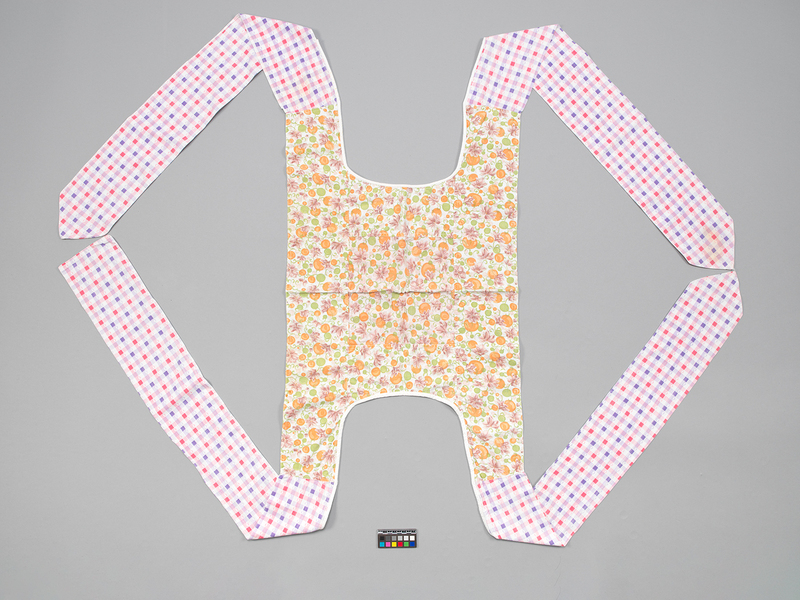Baby Carrier Item Number: 3426/1 from the MOA: University of British Columbia

Description
Cloth baby carrier (or baby sling). The centre is an H-shape, a combination of five pieces of fabric sewn together with a square at centre. On one side, the square is red, embroidered with flowers, a guardian lion(?), a phoenix and Chinese characters, one in each corner. The fabric is off-white with dark purple-brown flowers, and bright green and orange circles with vine-like swirls. Attached to each corner of the centre section are long, wide strips of fabric for tying in a white, purple and pink plaid with little diamond details.
History Of Use
These slings (meh dai 孭帶) are rarely used now but were still commonly used in the1970s. They can be used to carry babies from approximately 3 months to 3 years of age. This example is big enough to carry a child at the older end of the range and would be too large to hold a small baby. Some have a mesh of stitched cloth strips sewn on the upper edge to support the child’s head when needed. The child (ideally lying down) is placed on the square with his or her legs over the lower straps. With the upper straps under the child’s arms for support, he or she is carefully slung onto the mother’s back, with her bending over to support the child. She then grasps the straps in front of her body and holds them quite tightly, twisting them around to ensure the child is secure, and fastening them in a single knot, tucking the straps into the front straps on both sides to secure them. Older children, usually girls, were also sometimes expected to carry younger siblings in this way.
Narrative
Made by Say Nui Chung (鍾四女) almost 100 years ago (in the 1920s) and then modified for continued use by her daughter, Lai Yung Lam Chau (林周禮容) about 50 years later. The donor's grandmother, Say Nui Chung, was from the village of Wo Min Lane (禾眠里, meaning where the rice stalk lay) in Kaiping /Hoiping City (開平), Guangdong, China. In that village teenage girls used to be taught to do embroidery and the centre piece was made when her grandmother was 13 or 14 years old. The wrap was modified about 50 years later by the donor's mother, before her son was born. Lai Yung Lam Chau had a sewing machine at home and earned a living through sewing. The wrap was also used to carry her grandchild while she was babysitting. The donor’s sister was later given the carrier to use for her own granddaughter, but she didn’t end up using it as she had a modern baby carrier.
Item History
- Made by Say Nui Chung (Maker) and Lai Yung Lam Chau (Maker) in Kaiping, Guangdong, China during 1920
- Owned by Say Nui Chung
- Owned by Connie Lam before February 20, 2020
- Received from Connie Lam (Donor) on February 20, 2020
What
- Name
- Baby Carrier
- Identification Number
- 3426/1
- Type of Item
- carrier
- Material
- cotton fibre
- Overall
- height 262.0 cm, width 60.0 cm
Who
- Culture
- Chinese: Cantonese
- Creator
- Say Nui Chung (Maker) and Lai Yung Lam Chau (Maker)
- Previous Owner
- Say Nui Chung and Connie Lam
- Received from
- Connie Lam (Donor)
Where
- Holding Institution
- MOA: University of British Columbia
- Made in
- Kaiping, Guangdong, China
When
- Creation Date
- during 1920
- Ownership Date
- before February 20, 2020
- Acquisition Date
- on February 20, 2020
Other
- Item Classes
- textiles
- Condition
- good
- Accession Number
- 3426/0001